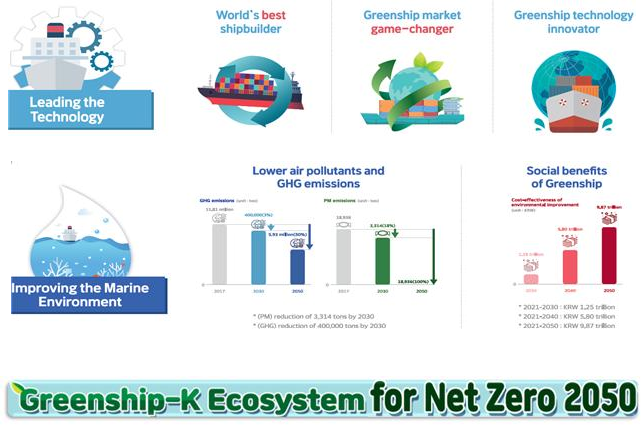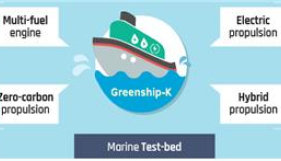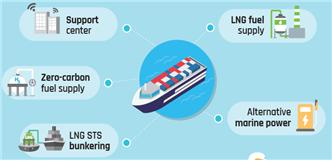"2030 Greenship-K Promotion Strategy" to Dominate the Global Green Ship Market
“2030 Greenship-K Promotion Strategy” to Dominate the Global Green Ship Market
The first national plan for the development and popularization of green ship (2021-2030)
With the aim of contributing to carbon neutrality in the global shipping industry, the Ministry of Oceans and Fisheries of the Republic of Korea (MOF) officially announced its initiative “The First National Plan for the Development and popularization of green ship (2021-2030)” on 23 December 2020 and officially named it as the “2030 Green ship-K Promotion Strategy.”
This strategy explores advanced emission-free technologies which enable to phase out greenhouse gases (GHG) emission up to 70 percent by 2030 in such an arena as ship design, future fuel, renewable energy and equipments and so on. Based on this newly established plan, MOF undertakes its challenging mission to facilitate both the public and private sector by turning 15% of the Korean-flagged ships (528 out of 3,542 ships) into greener ones.
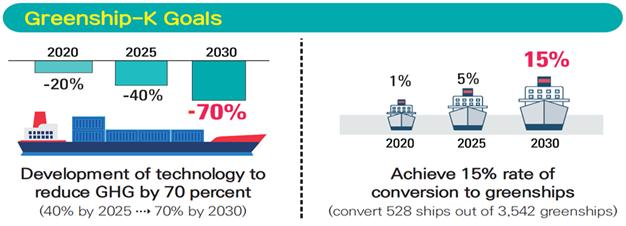
The International Maritime Organization (IMO) tackled the issues of climate change in the maritime sector and requested its member states to take up the ecological responsibility.
5,753 ships(including under construction)*, merely 5.6% of 102,960 ships in total, are equipped with eco-friendly features such as LNG fuel or SOX Scrubber. (Clarkson Research, 2020)
- * Scrubber (4,459 ships, 78%), LNG fueled ships (955 ships, 16%), Ships with alternative fuel (339 ships, 6%)
However, merely small portion of ships at present have been found converted into green ship, and it represents that Annual GHG emissions from the international shipping could not reach the target of 50% reduction by 2050, compared to 2008 (IMO, 2018)
From what the experts gather, that is why the European Union called for the maritime sector that the European Union’s Emissions Trading System (EU-ETS) should come into force from 2022 without delay.
Clarkson Research also indicates that an annual average growth rate (AAGR) of LNG-fueled ship is reaching 19%, and this prospect will be a foundational evidence showing that the number of green ships is expected to exceed that of diesel-fueled ships around 2025.
The efforts of the stakeholders in the global maritime sector towards greener trends will enable zero-carbon ships, e.g. hydrogen-fueled ships, to be commercialized by 2030 and will also lead to zero-carbonization of shipbuilding and equipments sectors.
Upon successful implementation of the “2030 Green Ship-K Promotion Strategy,” MOF forecasts that the GHG emission in 2050 (5.93 million tons) would be half of that in 2017 (11.81 million tons).
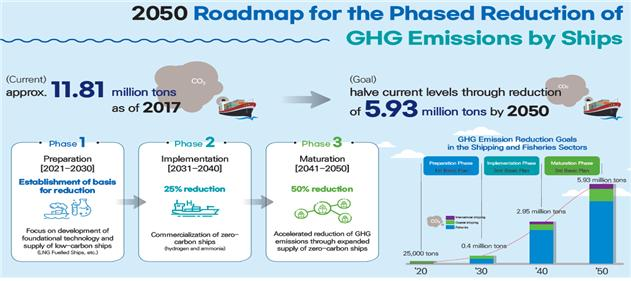
With the aforementioned goals, MOF provides the domestic maritime industry with solid track records by taking advantage of de-commissioned government-owned vessels for multi-purposed equipment tests and brand new coastal pilot ships for operation tests from 2020. Once the technologies introduced to domestic ships and the equipments are verified its commercial feasibility, the technologies are going to be applied to larger-scale oceangoing ships as well.
Expanding the infrastructure for LNG suppliance is the heart of popularization of green ships. The ports of Busan and Ulsan will accommodate LNG bunkering capacity of 1.4 million tons in conjunction with LNG bunkering ships, and the ports of Gwangyang, Incheon, Pyeongtaek, and Dangjin also will build them by 2030. A dual LNG carriage-bunkering purposed ship has already been engaged on its voyage, and two LNG bunkering ships are to be built by 2022.
In order to increase the number of green ships, MOF plans to build or convert 528 green ships (388 in the public sector and 140 in the private sector) by 2030.
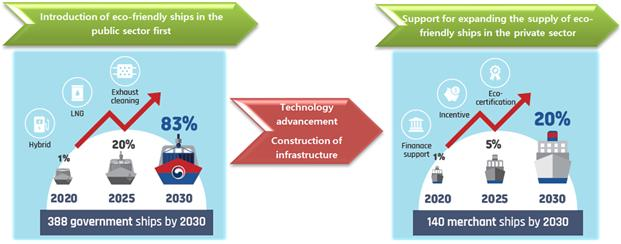
The new legislation mandates the Government, local governments and the public corporations to build the green ships when replacing their old vessels with new ones. The cost reduction in the private sector is underway. The high building costs and lack of fueling infrastructure lead the shipping industry to be reluctant to convert into green ship. To facilitate the shipping companies to step into greener community, the Government is formulating some forms of lowering eco-friendly fuel fees and port dues, inter alia. By doing so, the green ship project will sustain both the shipbuilding industry and local economies, creating a virtuous cycle in the industrial ecosystem. The economic prospect of the green ship initiative is anticipated to generate approximately 5 trillion KRW in sales in the shipbuilding and shipping industries and 11 trillion KRW in production and create more than 40,000 jobs by 2030.

The “2030 Green Ship-K Promotion Strategy” will contribute the global shipping community by improving the marine and atmospheric environment, reducing 3,314 tons of particulate matters and 4 million tons of GHG around 2030.
